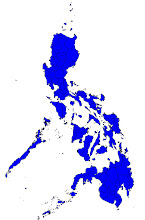From Philippine Daily Inquirer
Link:http://newsinfo.inquirer.net/inquirerheadlines/nation/view/20100331-261718/Poll-adviser-worried-over-loss-of-ballot-security-mark
Link:http://newsinfo.inquirer.net/inquirerheadlines/nation/view/20100331-261718/Poll-adviser-worried-over-loss-of-ballot-security-mark
MANILA, Philippines—Another hiccup has led to one less election safeguard.
A major security feature of the machines to be used in the automated elections on May 10 has reportedly been turned off after tests failed to sense the ultraviolet (UV) mark that would identify a genuine ballot.
Ramon Casiple, a member of the Commission on Elections (Comelec) Advisory Council, Tuesday expressed concern over the changes made on the security identifiers used in the ballots, saying the move could compromise the integrity of the elections.
Casiple said Smartmatic-TIM, the automated elections provider, and the Comelec had turned off the UV ink reader on all 82,2000 precinct count optical scan (PCOS) machines after the UV security marks on the ballots caused the machines to reject them.
“During the lab test performed last January, at least 20 percent of the ballots were not read by the PCOS machines,” Casiple said.
5 security measures
The UV ink mark is one of the five security measures in the automation contract. The others are the paper manufactured in Canada, bar code, Comelec security seal and the unique precinct-based numbers.
To replace the built-in PCOS UV reader, Comelec and Smartmatic-TIM will buy portable UV ink readers for the board of election inspectors (BEI) to use on Election Day to check the authenticity of the ballots, Casiple said.
“Before the BEI gives you the ballot, the BEI will shine the portable reader on it to show that there is the UV ink. What was supposed to be high-tech has become low-tech,” Casiple explained.
The Comelec is expected to purchase about 76,000 handheld UV readers for each precinct.
Lower security level
The adjustment could affect the conduct of the elections as the authenticity of the ballots will depend on the judgment of the teachers who are already burdened by other election duties and could lead to chaos and confusion, Casiple said.
He stressed that the ballots still have other security measures, but added that “if you are looking for high-level security measure, that has been lowered already.”
The PCOS is programmed to find and read the UV markings on the same spot in the 50 million ballots that voters will use.
Comelec officials have reported that the machines could not read the UV ink marks if they overlap with the ink for the names of the candidates and contests on the ballot.
When the issue was revealed during the tests in January, officials should have remedied the defects immediately, Casiple said.
No time for adjustments
They should have bought ink that could withstand the other inks, adjusted the ink density or the sensitivity of the PCOS machines, he said.
Since there was no time to adjust the placement of the security marks on the ballots, buy a new ink or configure the machines, the Comelec decided to do away with the built-in UV reader in the machines and use hand-held UV readers instead, Casiple said.
He said that the advisory council was only notified of the development this month after millions of ballots had been printed.
Commissioner Gregorio Larrazabal downplayed the lack of UV reader in the PCOS machines. He noted that there were still other security features in the ballots that would guard against tampering or copying.
“It’s only the authentic ballots that will be accepted by the machines. There are other security features,” Larrazabal said.
Multiple registrants
He also reported that the Comelec en banc Tuesday agreed to direct local election officers to cross-check the official voters’ registry with the list of 700,000 names considered to be double or multiple registrants.
Because the poll body does not want to disenfranchise some voters who had changed residences and had registered multiple times, the Comelec will not remove their original entry, he said.
“We are delisting them in their second or third registration,” Larrazabal said, so they can still vote under their first entry.
Nearly 51 million voters have registered for the upcoming balloting.
The Comelec dismissed as exaggerated poll watchdog estimates of between 4 million and 6 million double and multiple registrants.
No Holy Week break
To rush the printing of ballots, there will be no Holy Week break for the National Printing Office, Larrazabal said.
The fifth Kodak printer, which arrived last week, had been put to work, but had yet to reach its maximum printing capacity of 200,000 ballots per day.
So far, the Comelec has printed 27 million ballots, he said.




No comments:
Post a Comment